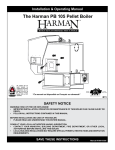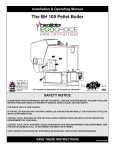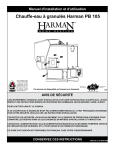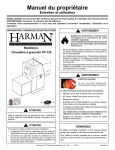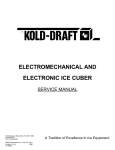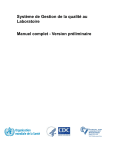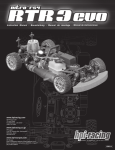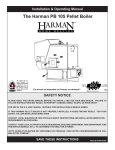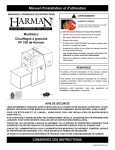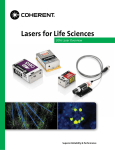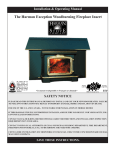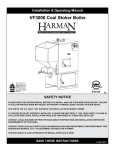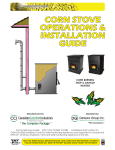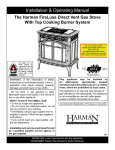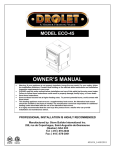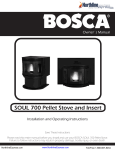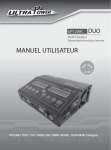Download Manual - Evergreen Home & Hearth
Transcript
Installation & Operating Manual The Harman PB 105 Pellet Boiler “Ce manuel est disponible en Français sur demande” R10 SAFETY NOTICE Warning! Risk of fire or exploision! • Improper installation, operation or maintenance of this boiler can cause injury or death. • Follow all instructions contained in this manual BEfore installation and use of this boiler: • Please Read and understand this entire manual. Consult your local authorities having jurisdiction. • Contact your municipal building department, Fire department, or other local authorities before installing this boiler. • Local building regulations may require special permits, restrictions and inspection requirements. save these instructions Manual #3-90-07205 Access Cover To Secondary Ash Chamber Ash Door Firebox Door Viewing Glass Access Cover To Hopper / Swing Plate Knob Control Board Cover Control Board Hopper Hopper Lid Latches 1-1/4” FMPT Supply 1/2” FMPT Boiler Drain Combustion Blower Cover Combustion Blower Vent Pipe 1-1/4” FMPT Return (Removed w/ Domestic Hot Water Option) Blank Cover Pressure Relief Valve Aquastat Well Temperature / Pressure Gauge Parts Locations 3 Introduction Table Of Contents Warranty 5 Assembly 6 Venting 9 Installation 12 Fuel Specifications 22 Operation 23 Maintenance 30 Troubleshooting 34 Atmospheric Conversion 35 Service Parts 36 Specifications 41 Wiring Diagram 42 Testing Label 44 Appliance Certification. Model: Pellet Burning Boiler - PB105 Test Lab: Omni-Test Laboratories, Inc. Report #: 135-S-16-6 Type: Pellet Fueled Central/Supplementary For Residential Use Standard(s): CAN/CSA B366.1-M91, and UL 391 Note: This appliance is also approved for installation into a shop. Quick Reference Start-UpBack Cover WARNING! RISK OF FIRE! Hearth & Home Technologies disclaims any responsibility for, and the warranty and agency listing will be voided by the following actions: DO NOT: • Install or operate a damaged appliance • Modify the appliance • Install other than as instructed by Hearth & Home Technologies • Operate the appliance without fully assembling all components • Operate the appliance without water in the system • Overfire the appliance • Install any component or part not approved by Hearth & Home Technologies Improper installation, adjustment, alteration, service, or maintenance can cause injury or property damage. For assistance or additional information, consult a qualified installer, service agency or your dealer. Please read this entire manual before you install and use your new boiler. Failure to follow instructions may result in property damage, bodily injury, or even death. SAVE THESE INSTRUCTIONS Hearth & Home Technologies, Inc. 4 352 Mountain House Road Halifax, PA 17032 Warranty HARMAN™ CENTRAL HEATING PRODUCTS LIMITED WARRANTY Hearth & Home Technologies Inc., on behalf of its Harman™ brand (”HHT”), extends the following warranty for all Harman™ furnace and boiler products (“Products”) that are purchased from an HHT authorized dealer. Warranty Coverage: Subject to the conditions, exclusions and limitations set forth below, HHT warrants to the original owner of the Products, and to any transferee taking ownership of the Products at the site of original installation within two years following the date of original purchase, that the Products will operate free from defects in material and workmanship under normal conditions and use, as described in the operating instructions furnished with the Product, during the warranty period described below. HHT will, at its option, repair or replace any Product covered by this warranty that is determined to be defective in material or workmanship. Warranty Period: The warranty period runs for six years, except for mechanical and electrical components, which are warranted for three years. The warranty period begins on the earlier of: (i) the date of invoice for the Product; (ii) in the case of new home construction, the date of first occupancy of the residence or six months after the date of sale of the Product by an HHT authorized dealer, whichever occurs first; or (iii) the date 24 months following the date of Product shipment from HHT, regardless of the invoice or occupancy date. Warranty Conditions: This warranty applies only to Products: (i) installed, operated, and maintained as recommended in the Product user’s manual; (ii) purchased through an HHT authorized dealer; (iii) while remaining at the site of original installation; and (iv) that have not been altered after leaving the factory. How to File a Claim: Claims must be made within the warranty period to the dealer who sold the Product. If that dealer cannot provide the warranty service, contact the nearest HHT authorized dealer. Additional service fees may apply if you are seeking warranty service from a dealer other than the dealer from whom you originally purchased the Product. Travel and shipping charges for parts are not covered by this warranty. Warranty Exclusions: This warranty does not cover the following: (1) consumable and normal wear items, including, without limitation, flame guides, grates, coal bars, afterburner hoods, fire brick, gaskets, paint, glass discoloration, burnpot housing weldments, burnpot grate weldments (pellet or corn), burnpot front plates (pellet or corn), burnpot front plate locks, corn auger extensions, ceramic inserts, and ceramic insert plates; (2) noise caused by minor expansion, contraction or movement of parts; (3) damage resulting from: (i) failure to install, operate or maintain the Product according to the installation and operating instructions and listing agent identification label furnished with the Product; (ii) failure to install the Product according to local building codes; (iii) shipping or improper handling; (iv) abuse, misuse, continued operation with damaged, corroded or failed components, accident, or incorrectly performed repairs; (v) environmental conditions, inadequate ventilation, negative pressure or drafting caused by tightly sealed construction, insufficient make-up air supply, or handling devices such as exhaust fans or forced air furnaces or other such causes; (vi) use of fuels other than those specified in the operating instructions; (vii) installation or use of components or accessories not supplied with the Product or authorized and approved in writing by HHT; (viii) modification of the product not expressly authorized and approved by HHT in writing; or (ix) interruptions or fluctuations of electrical power supply to the Product; (4) non-HHT components or accessories used in conjunction with the Product; (5) the Products’ capability to heat a desired space; information is provided to assist the consumer and the dealer in selecting the proper Product for the application; consideration must be given to Product location and configuration, environmental conditions, insulation and air tightness of the structure; or (6) additional or unusual utility bills incurred due to any malfunction or defect in Products. Limitations of Liability: Repair or replacement in accordance with the provisions of this warranty will be the owner’s exclusive remedy for and will constitute HHT’s sole obligation under this warranty, under any other warranty (express or implied), or in contract, tort or otherwise. No employee, agent, dealer, or other person is authorized to give any warranty on behalf of HHT. TO THE EXTENT ALLOWED BY LAW, HHT MAKES NO OTHER WARRANTY, EXPRESS OR IMPLIED, INCLUDING ANY WARRANTY OF MERCHANTABILITY OR FITNESS FOR A PARTICULAR PURPOSE. HHT WILL NOT BE LIABLE FOR ANY CONSEQUENTIAL OR INCIDENTAL DAMAGES ARISING OUT OF DEFECTS IN OR USE OF THE PRODUCTS. Some states do not allow exclusions or limitation of incidental or consequential damages, so these limitations may not apply to you. This warranty gives you specific rights; you also may have other rights, which vary from state to state. The duration of any implied warranty is limited to the duration of the warranty period specified herein. 5 Assembly Boiler Kit Materials: (Refer to page 3) List of items contained within the boiler kit shipped with the unit. 1 - Control board cover 1 - Access cover (Hopper Swing Plate Knob) 5 - Spring Handles 1 - 1/2” Boiler Drain 1 - 3/4” Safety Relief Valve 1 - 1/2” Aquastat Well 1 - 1/2” Dual Temperature/Pressure Gauge 1 - 100ft. Sensor Cable (Outdoor Air Sensor) 1 - Outdoor Air Sensor 1 - Flue Tunnel Weldment 1 - Combustion Blower Assembly 1 - Heat Shield (Comb. Blower) 2 - UY Connectors 2 - Terminals 1/4 Female 1 - #8 X 1/2” TEK 3 - 1/4-20 X 5/8” Wing Screw 4 - 1/4” Lock Washer 4 - 1/4-20 Nuts Installation of the Flue Tunnel Weldment, Combustion Blower and Wiring, ESP and Heat Shield: Step 1: First install the flue tunnel weldment by aligning the (4) studs with the (4) holes in the ash chamber base. Fasten the (4) nuts and lock washers provided, to the studs by removing the access cover on the secondary ash chamber. Step 2: Place the combustion motor onto the flue tunnel weldment and tighten the (3) wing screws provided. Step 3: Insert the Exhaust Sensing Probe (ESP) into the 1/8” hole provided on the flue pipe stub. Fasten with the (1) #8x1/2” TEK screw also provided. ESP will be taped to the sheet metal jacket for shipping purposes. Step 4: Connect the flex conduit 90 degree elbow(Not Shown) to the heat shield in the hole provided. Then connect the (3) wires from the combustion blower with the (3) wires in the flex conduit by using the push-on connectors and matching the wire colors as follows: Red to Black, White to White and Green to Green. Step 5: Place Heat Shield over combustion blower and align the swell latches with the holes in the sheet metal and tighten. Flue Tunnel Weldment ESP Combustion Blower Heat Shield NOTE: Refer to Fig’s 22, 23, and 24 located on page 33 of this manual. 6 Assembly 42" CANADA 42" CANADA 18" CAN 16" USA 40" USA 40" USA Refer to the illustration on page 3 to identify the compoMINIMUM NON-COMBUSTIBLE FLOOR PROTECTION AREA nents listed below: 1. Install the control board cover as well as the access cover located on the feeder cover. 2. Install the spring handles provided with the unit on the NON-COMBUSTIBLE ash door, firebox door and the heat exchanger cleanout rod FLOOR PROTECTOR handles. (Fasten handles by turning them counterclockwise and pushing inward simultaneously). 3. Install 1/2” MPT boiler drain in the fitting as shown. Note: Use pipe thread sealant or teflon tape on ALL threads before connections are made. 4. Install 3/4” MPT pressure relief valve as shown. 5. Install the 1/2” MPT aquastat well in fitting as shown, 55" USA & CAN then place aquastat in the well and fasten with a zip tie. The aquastat sensor is located under the top sheet metal jacket. 6. Install the 1/2” MPT temperature/pressure gauge in fitting as shown. 7. Locate and install outside air temperature sensor. Location of this sensor should be on the north side of the home or building and out of direct sunlight. Use the cable supplied with the boiler to attach the sensor to the terminals located on the hopper. (Place at the back side just above and to the right of the main power connection box) The wires can be connected to the sensor with the connectors supplied. Wire nut or butt splice connectors could also be used. The connections at the boiler can be done with the two 1/4” female 55" USA & CAN push on connectors supplied. 8. Fasten the conduit to the ash base with the clamps Floor Protection: provided. The striped area indicates the minimum required floor protection area if the boiler is going to be placed on a combustible floor. It requires 40” X 55”(US) or 42” X 55”(CAN) of non combustible floor protection as shown. 16”(US) or 18”(CAN) Design: The first thing that needs to be done is deciding where and of the floor protection must be in front of the firebox door as shown. Floor protection must be a minimum of 26 gauge how the boiler will be installed. Things that need to be taken into consideration are the sheet metal. Floor protection must also be provided under any intended use of the boiler for example, is the boiler going to horizontal run of vent pipe equal to the outside diameter of the be used as your primary heating system or is it going to be venting plus 2” to each side. used as a secondary or backup heating system. If it is to be Example: 4” type “L” or “PL” vent pipe has an outside diamused in conjunction with an existing oil or gas boiler system eter of 4-1/2” + 2” on each side equals a protected floor area will it be piped in parallel or in series? The answers to these of 8-1/2” wide underneath the horizontal run. and other questions can be determined by talking to your certified dealer or a qualified HVAC or plumbing contractor. This will ensure that the boiler is installed and piped to accommodate your needs and expectations. Consideration must be given to the venting as well as electrical and clearance requirements. (Clearances must be maintained to combustibles and also for service) Make sure fans are not used in the fuel storage area, unless they are installed so as not to create a negative pressure in the room where the solid fuel burning appliance is located. 7 Assembly INSTALLATION IS TO BE PERFORMED BY A QUALIFIED INSTALLER. NOTE: All installation clearances and restrictions must be adhered to. NOTE:Use only 4” diameter type “L” or “PL” venting system. Be sure to inspect and clean exhaust venting system frequently. 8 Venting Requirements for Terminating the Venting WARNING: Venting terminals must not be recessed into a wall or siding. NOTE: Only PL vent pipe wall pass-throughs and fire stops should be used when venting through combustible materials. NOTE: Always take into consideration the effect the prevailing wind direction or other wind currents will cause with flyash and /or smoke when placing the termination. In addition, the following must be observed: A. The clearance above grade must be a minimum of 18”.1 B. The clearance to a window or door that may be opened must be a minimum of 48” to the side, 48” below the window/door, and 12” above the window/ door.1 C. A 12” clearance to a permanently closed window is recommended to prevent condensation on the window. D. The vertical clearance to a ventilated soffit located above the terminal within a horizontal distance of 2 feet (60 cm) from the center-line of the terminal must be a minimum of 18”. E. The clearance to an unventilated soffit must be a minimum of 12”. F. The clearance to an outside corner is 11” from center of pipe. G. The clearance to an inside corner is 12”. H. A vent must not be installed within 3 feet (90 cm) = Vent terminal = Air supply inlet above a gas meter/regulator assembly when measured from the horizontal center-line of the regulator.1 I. The clearance to service regulator vent outlet must be a minimum of 6 feet.1 J. The clearance to a non-mechanical air supply inlet to the building or the combustion air inlet to any other appliance must be a minimum of 48”.1 K. The clearance to a mechanical air supply inlet must be a minimum of 10 feet.1 L. The clearance above a paved sidewalk or a paved driveway located on public property must be a minimum of 7 feet.1,2 M. The clearance under a veranda, porch, deck or balcony must be a minimum of 12 inches.1,3 (B Also applies) NOTE: The clearance to vegetation and other exterior combustibles such as mulch is 36” as measured from the center of the outlet or cap. This 36” radius continues to grade or a minimum of 7 feet below the outlet. 1 Certain Canadian and or Local codes or regulations may require different clearances. 2 A vent shall not terminate directly above a sidewalk or paved driveway which is located between two single family dwellings and serves both dwellings. 3 Only permitted if veranda, porch, deck, or balcony is fully open on a minimum of 2 sides beneath the floor. NOTE: Where passage through a wall, or partition of combustible construction is desired, the installation shall conform to CAN/CSA-B365. (if in Canada) = Area where terminal is not permitted Fig. 2 9 Venting Fig. 3 Avoiding Smoke and Odors - Negative Pressure, Shut-down and Electrical Power Failure. To reduce the probability of back-drafting or burn back in the pellet boiler during a power failure, it must be able to draft naturally without exhaust blower operation. Negative pressure in the house will resist this natural draft if not accounted for during installation. Heat rises in a house, and leaks out at upper levels. This air must be replaced with air from outside the dwelling, which normally flows into lower levels. Vents and chimneys into basements and lower levels can become the conduit for return air and reverse under these conditions. Hearth & Home Technologies strongly recommends the use of outside air in all pellet boiler installations, especially those on lower level and main floor locations. Per national building codes, consideration must be given to combustion air supply to all combustion appliances. Failure to supply adequate combustion air for all appliance demands may lead to back-drafting of those and other appliances within the home. 10 To reduce the probability of reverse drafting during shut-down conditions, Hearth & Home Technologies strongly recommends: • Installing the pellet vent with a minimum vertical run of 5 feet. Preferably terminating above the roof line. • Installing the outside air intake at least four feet below the vent termination. To prevent soot damage to exterior walls, and to prevent re-entry of soot or ash into the house: • Maintain specified clearances to windows, doors and air inlets, including air conditioners. • Vents should not be placed below ventilated soffits. Run the vent above the roof. • Avoid venting into alcove locations. • Vents should not terminate under overhangs, decks or onto covered porches. • Maintain minimum clearance of 12” from the vent termination to the exterior wall. Extending this distance may be required if visual accumulation occurs. Venting Venting Venting Use 4” pellet vent pipe only. A combustion blower is used to extract the combustion gases from the firebox. This creates a negative pressure in the firebox and a positive pressure in the venting system as shown in Fig. 4. The longer the vent pipe and more elbows used in the system, the greater the flow resistance. Because of these facts we recommend using as few elbows as possible and 30 feet or less of vent pipe. The maximum horizontal run should not exceed 18 feet. Be sure to use wall and ceiling pass through fittings (which are approved for pellet vent pipe ) when going through combustible materials. Be sure to use a starting collar to attach the venting system to the stove. The starting collar must be sealed to the stove flue collar with high temp silicone caulking or aluminum tape, and screwed into the stove flue collar at least three (3) places. + - Fig. 4 Vent Pipe 4” pellet vent pipe (also known as “PL” vent) is constructed of two layers with air space between the layers. This air space acts as an insulator and reduces the outside surface temperature to allow a minimum clearance to combustibles as low as 1 inch. In Canada the minimum clearance to combustibles is 3 inches. The sections of pipe lock together to form an air tight seal in most cases; however, in some cases a perfect seal is not achieved. For this reason and the fact that the boiler operates with a positive vent pressure, we specify that all joints within the structure should also be sealed with silicone. NOTE:Use only 4” diameter approved PELLET venting system. Be sure to inspect and clean exhaust venting system frequently. 4” Type “L” or “PL” Vent pipe Fig. 5 This is the minimum venting configuration. The minimum vent configuration is a 90o or Tee on a starter collar and a 24” length horizontal through an exterior wall. A cap on the end should direct the flue gasses down and away from the structure. See Fig. 5. The maximum horizontal length is 18 feet. The minimum termination height above the exterior grade is 18”. The maximum total length of any configuration is 30 feet*. * ( see venting graph on page 10 for exceptions ) NOTE: Cleanout Tee’s should always be used on the transitions to horizontal pipe to allow easy access for cleaning. The venting graph allows for one(1) 90 deg. or Tee fitting in any configuration. If more 90’s, T’s, or 45’s are needed, the total length must be adjusted to allow for the added restriction. Up to four (4) additional 90’s, Tee’s, or equivalent 45’s can be added as long as the overall length is adjusted in accordance with the values listed below. ( See the venting graph on page 10.) Each Vertical ---- 90 deg. or T subtract 2.5 feet Each Vertical ---- 45 deg. subtract 1.5 feet Each Horizontal - 90 deg. or T subtract 5.0 feet Each Horizontal - 45 deg. subtract 2.5 feet Any exterior venting (vent pipe exposed to outside ambient temperatures) should be kept to a minimum, due to potential condensation problems. This is especially important in high humidity cold weather climates, such as maritime areas, lake shores, and low river valleys. 11 Venting Installation NOTE: Use only 4” diameter approved pellet venting system. Be sure to inspect and clean exhaust venting system frequently. INSTALLATION IS TO BE PERFORMED BY A QUALIFIED INSTALLER. DO NOT INSTALL A FLUE DAMPER IN THE EXHAUST VENTING SYSTEM OF THIS UNIT. DO NOT CONNECT THIS UNIT TO A CHIMNEY FLUE SERVING ANOTHER APPLIANCE. Chimneys taller than 20’ above the connection will require a draft test to determine if the draft is too high. Note: The high burn draft should not exceed .85 IWC. Some form of a restrictor plate may be required at the top of high chimneys to reduce the draft. See page 21 for the Draft Test procedure. This boiler may be used and installed into an existing masonry or Class A metal chimney. Certain Canadian and Local Codes may require that the chimney be fully relined. The venting Can Not be installed in a chimney serving another appliance. The chimney should be cleaned and or inspected before installation of the venting. INSTALL VENT WALL PASS-THROUGHS AT CLEARANCES SPECIFIED BY THE VENT MANUFACTURER NOTE: All installation clearances and restrictions must be adhered to. NOTE: Read and follow all of the vent pipe manufacturers’ instructions on the proper installation and support of the vent pipe. Adhere to all clearances. WARNING Keep combustible materials such as grass, leaves, etc. at least 3 feet away from the point directly under the vent termination. (between the vent and the ground) CAUTION Keep combustibles away from flue outlet. Other examples of possible installations of the venting. Creosote - Formation and Need for Removal - When wood is burned slowly, it produces tar and other organic vapors, which combine with expelled moisture to form creosote. The creosote vapors condense in the relatively cool chimney flue of a slow-burning fire. As a result, creosote residue accumulates on the flue lining. When ignited, this creosote makes an extremely hot fire. The pellet vent pipe should be inspected at least twice monthly during the heating season to determine if a creosote buildup has occurred. If creosote has accumulated it should be removed to reduce the risk of a chimney fire. Guidance on minimizing creosote formation and the need for periodic creosote removal: The chimney should be inspected during the heating season to determine if a creosote build-up has occurred. If a significant layer of creosote has accumulated (3mm or more) it should be removed to reduce the risk of a chimney fire. 12 Installation Outside Air Inlet Cover part# 1-10-09542 Fig. 6 Outside Air Pipe Knockout Feeder Cover Fig. 7 Outside Air Inlet Pipe To install outside air, use 2 3/4” I.D.galvanized steel flex pipe, part # 2-00-08544 ( 12’ 6” length) or part # 2-00-08545 ( 25’ length) See Fig. 6. There is a breakaway hole on the rear panel which must be removed before connecting the flex pipe. See Fig. 7. When the appliance is side wall vented: The air intake is best located on the same exterior wall as the exhaust vent outlet, and located lower on the wall than the vent outlet. When the appliance is roof vented: The air intake is best located on the exterior wall oriented toward the prevailing wind direction during the heating season. Never terminate the outside air above the vent pipe outlet. The maximum length of this pipe is 20 feet. Inlet cover part number 1-10-09542 should be used to keep birds, rodents etc.out of the inlet pipe. See Fig.6. NOTE: The inlet cover should not be placed in an area where drifting of snow or ice will build up, blocking the intake air supply. The Outside Air knockout is located on the face of the Feeder Cover. It is pre-cut except for several small tabs. There is also a filler plate screwed to the inside to cover the top of the hole after the Outside Air Pipe has been installed. This will allow for removal of the Feeder Cover without disconnecting the Outside Air Pipe. See Fig. 7. Only metal Intake Flex should be used for the Outside Air Supply connection. The Outside Air Intake Pipe is inside the Feeder Cover and to the right of the feeder motor. The 2 3/4” steel flex pipe is made to slide over the outside of the Air Intake Pipe. See Fig. 8. It should be held into place with some silicone, foil tape, or a hose clamp. (not supplied) Heat Reclaiming Ventilation System (HRV) When installing in a house with a Heat Reclaiming Ventilation System (HRV) be sure the system is balanced and is not creating a negative pressure in the house. Hopper/Feeder Swing Plate Knob Fig. 8 13 This boiler should never be powered by the use of an extension cord. The recommended high and low voltages are, 130 V.A.C. 60 Hz maximum high voltage, and 113 V.A.C. 60 Hz minimum low voltage.The furnace will continue to operate at voltages as low as 105 V.A.C. , although it can not be guaranteed that automatic ignition will occur. NOTE: If other sources of electrical power are to be used ( such as a generator ) for normal operation or emergency operation, this source should be checked before installation. Many generators and inverters may not supply 120V.A.C. 60Hz. power stable enough to operate the control board properly. (Control board damage could occur). To install power to the boiler, first remove the cover on the 4” X 4” junction box located on the back of the unit. There are several knockout holes provided for the incoming main power wires. Also, a knockout hole can be used for the auxiliary output overheat zone (if used). The minimum recommended circuit is 6 AMP - 120 VAC - 60 HZ. This boiler should be the only appliance on the circuit. If a 15 AMP circuit breaker is used at the distribution box, the boiler must be protected with an in-line fuse rated at 6 AMP. Main Wiring Installation 14 Installing Duct Installation NOTE: Cold return water temperature (Sustained temperatures below 140 degrees Fahrenheit) will lead to condensation in the firebox. This moisture can lead to creosote formation. To help minimize moisture and creosote, it is strongly recommended that some form of temperature balance is incorporated into the return water system. NOTICE: When installing with the atmospheric conversion: All of the pressurized system components shown are not necessary. Air vents or bleeders will need to be removed from the plumbing system to prevent air from entering the lines. Control Dipswitch #6 will need to be turned “ON”. 15 Installing Duct/Air Conditioning Installation Boilers intended to be connected to an existing boiler or boiler system shall: 1. Be capable of being installed without interfering with the normal delivery of heated water from the original boiler to the radiation system. 2. Be capable of being installed to operate as intended without affecting the operation of the electrical and mechanical safety controls of the original boiler. 3. Provide, upon completion of the installation, for a change over from one fuel to the other without requiring the manual adjustment of any controls or components other than the thermostats. 4. Be compatible with the operation of a service water-heating coil within the original boiler without bypassing the operation of the solid-fuel boiler. 5. Have provision for preventing, or adequate water capacity within the boiler to prevent, damage to the boiler from loss of circulation due to electrical power failure. 6. Be capable of being installed without changing the function of the control or rewiring of the original boiler. A wiring interconnection is permitted. The electrical system of both boilers shall be powered from a single branch circuit without exception. (CAN/CSA-B366.1-M91) 7. Pertaining to CAN/CSA- B365-01, Have a clearly labelled device, located at each entrance to the boiler area, which can be thrown to discontinue operation of the feed system. NOTICE: When installing with the atmospheric conversion: All of the pressurized system components shown are not necessary. Air vents or bleeders will need to be removed from the plumbing system to prevent air from entering the lines. Control Dipswitch #6 will need to be turned “ON”. 16 Installation EXAMPLE OF TYPICAL TANKLESS DOMESTIC HOT WATER PIPING HIGH TEMPERATURE WATER (IF NEEDED) TEMPERED HOT WATER TO SHOWERS AND FAUCETS NOTE: ALWAYS REFER TO THE INDIVIDUAL COMPONENTS RECOMMENDED INSTALLATION INSTRUCTIONS FOR THE PROPER MOUNTING POSITION AND LOCATION WITHIN THE PIPING SYSTEM. OPTIONAL DOMESTIC HOT WATER COIL INLET MIXING VALVE OUTLET MIXING VALVE SET TO DESIRED WATER TEMPERATURE. NORMALLY NOT MORE THAN 120 DEGREES. AQUASTAT WELL LOCATION HOSE BIB TO BACKFLUSH COIL IF NEEDED SAFETY RELIEF VALVE ISOLATION VALVE FLOW REGULATOR COLD WATER SUPPLY HOSE BIB FLOW REGULATOR WILL NEED TO MATCH THE GPM RATING OF THE DOMESTIC COIL. (IF USING A DOMESTIC COIL, 4 GPM IS REQUIRED.) EXAMPLES OF TYPICAL DOMESTIC HOT WATER STORAGE PIPING EXAMPLE #2 EXAMPLE #1 HIGHER TEMPERATURE WATER (IF NEEDED) FROM BOILER FROM BOILER COLD TEMPERED HOT WATER FOR SHOWERS AND FAUCETS HOT COLD CIRCULATOR DOMESTIC HOT WATER STORAGE HEATER HOT MIXING VALVE SET TO DESIRED WATER TEMPERATURE. NORMALLY NOT MORE THAN 120 DEGREES. CIRCULATOR DOMESTIC HOT WATER STORAGE HEATER IN TO BOILER IN OUT MIXING VALVE TO BOILER NOTE: ALWAYS REFER TO THE INDIVIDUAL COMPONENTS RECOMMENDED INSTALLATION INSTRUCTIONS FOR THE PROPER MOUNTING POSITION AND LOCATION WITHIN THE PIPING SYSTEM. OUT NOTE: TYPICALLY, AS LONG AS THE WATER TEMPERATURE NEEDED IS NOT MORE THAN 120 F, THE MIXING VALVE SHOWN ABOVE (EXAMPLE 2) IS NOT NEEDED 17 Installation TYPICAL BOILER HOT WATER PIPING SHOWING AIR REMOVAL SYSTEM, PROVISIONS FOR THE EXPANSION OF WATER AND THE AUTOMATIC COLD WATER SUPPLY. ALSO SHOWN IS THE AUTOMATIC MIXING VALVE. THIS COULD ALSO BE DONE BY (2) CLOSELY SPACED TEE'S. THE PROPER PIPING FOR THE INTENDED USE WILL BE DETERMINED BY THE INSTALLING CERTIFIED PLUMBER OR HVAC CONTRACTOR. NOTE: ALWAYS REFER TO THE INDIVIDUAL COMPONENTS RECOMMENDED INSTALLATION INSTRUCTIONS FOR THE PROPER MOUNTING POSITION AND LOCATION WITHIN THE PIPING SYSTEM. ** THERMOMETER AIR VENT AIR SCOOP SYSTEM SUPPLY 1-1/4" SHUT-OFF VALVE UNION SYSTEM SUPPLY 1-1/4" AUTOMATIC MIXING VALVE * TEMPERATURE/PRESSURE GAUGE * AQUASTAT WELL SHUT-OFF VALVE COLD WATER SUPPLY 1/2" * PRESSURE RELIEF VALVE EXPANSION TANK (DIAPHRAGM TYPE) PRESSURE REDUCING VALVE (PRV) OR COMBINATION PRV AND RELIEF VALVE PIPE TO WITHIN 6" OF THE FLOOR OR A FLOOR DRAIN UNION CHECK VALVE (OR BACKFLOW PREVENTER IF REQUIRED) ** THERMOMETER SENSING BULB SHUT-OFF VALVE SYSTEM RETURN 1-1/4" * ITEMS SUPPLIED ** OPTIONAL * BOILER DRAIN, 1/2" NPT MALE X 3/4" HOSE MALE (NOT SHOWN) NOTE: Cold return water temperature (Sustained temperatures below 140 degrees Fahrenheit) will lead to condensation in the firebox. This moisture can lead to creosote formation. To help minimize moisture and creosote, it is strongly recommended that some form of temperature balance is incorporated into the return water system. NOTICE: When installing with the atmospheric conversion: All of the pressurized system components shown are not necessary. Air vents or bleeders will need to be removed from the plumbing system to prevent air from entering the lines. Control Dipswitch #6 will need to be turned “ON”. 18 Installation NOTE: Cold return water temperature (Sustained temperatures below 140 degrees Fahrenheit) will lead to condensation in the firebox. This moisture can lead to creosote formation. To help minimize moisture and creosote, it is strongly recommended that some form of temperature balance is incorporated into the return water system. NOTICE: When installing with the atmospheric conversion: All of the pressurized system components shown are not necessary. Air vents or bleeders will need to be removed from the plumbing system to prevent air from entering the lines. Control Dipswitch #6 will need to be turned “ON”. 19 Over Heat Safety Zone OverHeat Safety Zone (Dump Zone): STRONGLY RECOMMENDED in all installations. When the pellet boiler is operating at High burn, and all demand from the heating system stops, the control will reduce the feed rate and shut down completely as necessary. This may take several minutes, and the remaining heat may cause the water temperature to continue to rise. If the temperature gets too high, the OVERHEAT SAFETY ZONE light on the control (see page 23) will illuminate, and the DARK BLUE circuit in the junction box is energized(see wiring diagram). This circuit will flow 120V to operate a circulator pump installed to flow to the overheat dump zone established in the original installation plan. If opening a zone valve is the chosen method of dumping the excess heat, a voltage reduction relay will most likely be needed. If the water temperature continues to rise to the risk of boiling point, the feed system will stop and the boiler will shut-down. A manual reset will then be required to operate the boiler. Without a dump zone in place, the excess temperature could build pressure to the point of opening the relief valve, or with the atmospheric conversion it may allow the water to boil and exit through the over-flow of the atmospheric tank. Both scenarios may create water damage and/or a slip hazard. The boiling temperature of water varies at different altitudes and atmospheric pressures. Therefore, at elevations above 3000 feet, and when using the atmospheric conversion, circuit board dipswitch #6 must be in the “ON” position. Power Failure / Heat Dissipation Loop EXAMPLE OF PIPING IN ACCORDANCE WITH (CAN/CSA-B366.1) A POWER FAILURE HEAT DISSIPATION LOOP BALANCING VALVE SYSTEM SUPPLY MINIMUM OF 72" OF 3/4" FINNED BASEBOARD BASEBOARD MUST BE AT LEAST 24" HIGHER THAN BOILER FOR PROPER GRAVITY FLOW (HIGH TEMPERATURE) BASEBOARD HEAT POWER FAILURE SYSTEM SUPPLY 3/4" * TEMPERATURE/PRESSURE GAUGE UNION * AQUASTAT WELL 120VAC,NORMALLY OPEN,FULL FLOW, SOLENOID VALVE or EQUIVALENT * PRESSURE RELIEF VALVE THE SOLENOID SHOULD BE POWERED BY THE SAME CIRCUIT AS THE BOILER PIPE TO WITHIN 6" OF THE FLOOR OR A FLOOR DRAIN POWER FAILURE SYSTEM RETURN 3/4" SHUT-OFF VALVE UNION SHUT-OFF VALVE * ITEMS SUPPLIED 20 SYSTEM RETURN NOTE: ALWAYS REFER TO THE INDIVIDUAL COMPONENTS RECOMMENDED INSTALLATION INSTRUCTIONS FOR THE PROPER MOUNTING POSITION AND LOCATION WITHIN THE PIPING SYSTEM. 20 Installation Firebox Door Draft Bolt Location Air Wash Slot Air wash Slot Viewing Window Fig. 9 “Test” Draft Test Procedure After the venting is completed, the firebox low draft will need to be checked and possibly adjusted. After removing the 3/8” bolt from the draft hole shown in Fig. 9, insert the draft meter tube. The appliance doors and hopper lid must be latched during this test. (It is recommended that the draft meter have a scale of 0 to 1” WC.) Turn the feed adjuster to “Test”. this will start the combustion blower and allow you to check and record the High Draft ______ - IWC date _______ The maximum draft must not exceed -.85” W.C. Some form of vent restrictor may be needed. (There is no control board adjustment for the High Draft) After the first 60 seconds the “Test” mode lowers the combustion blower voltage to the Low Burn voltage. During this lowered voltage cycle the Low Burn Draft must be checked and adjusted if necessary. The recommended low draft setting should be between -.25 & -.35 IWC. Depending on the amount of vertical rise, it may not be possible to get a low draft reading in this range. In this case, a maximum low draft of -.55 is acceptable. The adjustment screw is through the small hole to the right of the Igniter Light. See Fig. 10. Adjusted Low Draft is __________ -IWC. Don’t forget to turn the feed adjuster off of “Test”. Do not operate if the high draft exceeds -.85” W.C. Excessive draft readings may be due to restriction in the combustion air supply. Check for obstructions. Low Draft Adjustment Pot Fig. 10 Covered Un-Covered The Control The boiler has the option to have the control panel covered or un-covered See Fig. 11. There is a pair of slots provided for each position. Simply move the cover to the desired position by placing the tabs on the cover in the proper slots. CAUTION: Hot while in operation. Do not touch. Keep children, clothing, furniture, and other combustible material out of the installation clearance area. WARNING: Do not operate with the hopper lid or fire chamber or ash removal doors open. Fig. 11 WARNING: Do not store fuel or other combustible material within installation clearance area. 21 Fuel Specifications Fuel and Fuel Storage Pellet fuel quality can fluctuate from manufacturer to manufacturer, and even from bag to bag. Hearth & Home Technologies recommends using only fuel that is certified by the Pellet Fuels Institute (PFI). Fuel Material • Made from sawdust and/or other wood by-products • Source material typically determines ash content Higher Ash Content Material • Hardwoods with high mineral content • Bark and leaves as source material • “Standard” grade pellets, corn and other biomass Lower Ash Content Material • Softwood; pine, fir, etc. • Materials with lower mineral content • “Premium” grade pellets Performance • Higher ash content requires more frequent maintenance. • “Premium” grade pellets will produce the highest heat output. • Burning pellets longer than 1-1/2 inches (38mm) can cause inconsistent feeding and/or ignition. We recommend that you buy fuel in multi-ton lots whenever possible. However, we do recommend trying different brands prior to purchasing multi-ton lots, to ensure your satisfaction. CAUTION! Tested and approved for use with wood pellets ONLY. Burning of any other fuel will void your warranty. When changing from “Premium” grade pellets to a “Standard” or “Economy” grade fuel, the FEED ADJUSTER will likely need adjusted to a lower setting. CAUTION! Do not burn fuel that contains an additive; When under maximum demand, ensure there is no unburned fuel being pushed into the ash pan. (such as soybean oil) • May cause hopper fire Storage • Damage to product may result • Wood pellets should be left in their original sealed Read the list of ingredients on the packaging. If you are bag until ready to use, to prevent moisture. buying wood pellets, the only ingredient listed should be • Do not store fuel within the specified clearance arwood fiber or sawdust. eas, or in a location that will interfere with routine Clinkers Minerals and other non-combustible materials, like sand, will turn into a hard glass-like substance when heated. Trees from different areas will vary in mineral content. For this reason, some fuels will produce more clinkers than others. Moisture Always burn dry fuel. Burning fuel with high moisture content takes energy to dry and tends to cool the appliance thus, robbing heat from your home. Damp pellet fuel could turn back into sawdust which does not flow properly through the feed system. Size • Pellets are either 1/4 inch or 5/16 inch (6-8mm) in diameter • Length should be no more than 1-1/2 inches (38mm) • Pellet length can vary from lot to lot from the same manufacturer 22 cleaning and maintenance procedures. CAUTION Tested and approved for use with wood pellets ONLY. Burning of any other fuel will void your warranty. NOTICE Hearth & Home Technologies is not responsible for stove performance or extra maintenance required as a result of using fuel with higher ash or mineral content. Operation Power Light Indicates power to the control board. Feed adjuster Sets the maximum feed rate Status Light Will be lit anytime there is a call for heat. Test Combustion blower, feed motor and safety dump zone are fully energized for the first minute. Afterward, combustion blower remains on low only. Overheat Safety Zone Light Indicates elevated boiler water temperature. Power flowing to Overheat circuit. Lighting Mode Selector Switched between Auto and Manual lighting Mode Selector/Min Temp Dial Used to turn the boiler on or off and set the desired minimum operating temperature of the boiler. Combustion Blower Light Indicates Power to combustion blower Feed Motor Light Indicates Power to the feed motor. Diagnostic Port For diagnostic purposes only. Requires special DDM monitor supplied to trained technicians exclusively. Igniter Light Indicates power to the igniter Max Temp dial The “Max Temp Dial” is used to set the desired maximum operating temperature of the boiler. Status light error messages: 3 Blinks: Indicates that the ESP (Exhaust Sensing Probe) has gone out of range, too many times. May indicate axcessive ash build-up in the exhaust stream. If the unit seems to be operating normally, perform a manual reset by cycling the main power off for a few seconds and re-connect. 4 Blinks: Indicates miscommunication with the aquastat, or the sensor is not attached properly. May require a manual reset. 5 Blinks: (In Auto Light Mode Only) Indicates that the igniter has failed to light the fire after 40 Minutes. To reset - Turn the Mode Selector/Min. Temp. to OFF and then back to the desired temperature. 7 Blinks: Boiler water over heat safety shut down. This requires a manual reset by cycling the main power off for a few seconds and re-connect. See explanation on page 20. Mode Selector/Min. Temp. Used to turn the boiler on or off and set the desired minimum operating temperature of the boiler. Max. Temp./ Min. Temp. Water Temperature Settings See “Setting the boiler temperature” found on page 24. OFF Mode Turning the Mode Selector/Min.Temp. to OFF will shut down the boiler. 6 Blinks : Indicates that the control has calculated poor or incomplete combustion occurring for 25 or more minutes. A six blink status may be set if the stove is allowed to run out of pellets. To reset, turn Mode Selector/Min Temp dial to “OFF” then back on to the desired temperature. If the unit was not out of pellets, see Troubleshooting section, Page 34, for more details. 23 Operation Setting The Boiler Temperature WATER TEMPERATURE MAX. TEMP. Control Board Operation MIN. TEMP. Aquastat Sensor - This sensor is located in the aquastat well on the top of the water jacket. This sensor along with the outdoor air sensor is what the control board uses to regulate the feed rate based on these two observed conditions. (Boiler Temp. & Outdoor Air Temperature) Outdoor Air Temp. Sensor (OAT) - This sensor is located outside the building (on the north side of the house and out of direct sunlight). The Outdoor Air Sensor is used to perform hot water reset based on outdoor air temperatures. When the OAT sensor is installed, at 20° F. or below (outside temperature), the boiler will operate at the temperature set on the MAX. TEMP. knob. The boiler water temperature will decrease by 1 degree F. for every 1 degree F. in temperature rise (above 20°) of the outdoor air. NOTE: Pellet Boiler Outdoor Air Reset Operation Graph located on page 25. 24 Without the Outdoor Air Temperature Sensor Installed To set the maximum boiler water temperature, simply turn the Max. Temp. water temperature dial to the desired setting. The control and the boiler will then perform to achieve and maintain the set temperature. The Min. Temp. Knob is the boiler water temperature minimum, or the lowest temperature the water will go before the unit re-starts. Turning the knob fully counter-clockwise is the “OFF” position, while turning the knob clockwise, past the 140 degree marking, is the “ON” position.. With The Outdoor Air Temp - Sensor Installed Maximum boiler temp setting is as described above. The MIN. TEMP. knob in addition to being the mode setting (on or off) now also has the function of setting the minimum boiler water temperature. This would be the lowest boiler water temperature that you want to have based on the following factors. 1.) Outdoor Air Temperature (OAT) 2.) Domestic Hot Water Use a.) Hot Water Coil Option b.) Indirect Hot Water Storage 3.) Overall Volume of the Heating System The boiler is designed to withstand lower return water temperatures however, extended return temperatures below 140 degrees F can cause condensation in the secondary ash chamber area and also in the venting system, which could cause damage in these areas. NOTE: If the system is run at the lower temperature settings, conditions of the firebox, boiler tubes, secondary ash chamber and venting should be monitored closely. If conditions show excess condensation, the boiler water minimum temperature will need to be increased until condensation does not occur. You should also consider some form of tempering of the return water system. Discuss this with your plumber. OAT 65o 60o 55o 50o 45o 40o 35o 30o 25o 20o 15o 10o 5o 0o Example 2 Max set at 180o Min set at 150o Water Temp 150o 150o 150o 150o 155o 160o 165o 170o 175o 180o 180o 180o 180o 180o Water Temp 140o 145o 150o 155o 160o 165o 170o 175o 180o 185o 185o 185o 185o 185o Degree Change * * * -30o -25o -20o -15o -10o -5o 0o 0o 0o 0o 0o Degree Change -45° -40° -35° -30° -25o -20o -15o -10o -5o 0o 0o 0o 0° * No change in boiler temperature after reaching minimum setpoint temperature. OAT 65o 60o 55o 50o 45o 40o 35o 30o 25o 20o 15o 10o 5o 0o Example 1 Max set at 185o Min set at 140o When the outdoor sensor is installed, at 20° F. or below OAT (Outdoor Air Temperature), the boiler will operate at the temperature set on the Maximum Temperature knob. The boiler water temperature will decrease by 1 degree for every 1 degree in temperature rise of the Outside Air. Pellet Boiler Outdoor Air Reset Operation Operation 25 Operation Starting A Fire Automatically 1. Turn Mode Selector to “OFF”. This resets the control in addition to turning it off. 2. Clean Burnpot with scraper, if necessary. Scrape burnpot to remove any carbon build-up that may have occurred Scraping can be done while in operation This is usually a weekly maintenance procedure. Cleaning the burn pot with the scraper with a small amount of new fuel in the bottom is not a problem. First, scrape the ashes on the front of the burn pot into the ash pan. Then scrape the hole grid surface downward into the burn pot. When the stove is ignited these scrapings will be pushed out by the feeder. The illustration at left shows the hopper swing plate open for easy access to the burn pot. The burn pot can also be reached through the firebox door. NOTE: To minimize the amount of stress placed on the hopper swing plate hinges, opening of the hopper swing plate should be done with the least amount of fuel in the hopper as possible. 3. Fill Hopper with pellets. When filling the hopper check for excessive fines in the bottom of the hopper. Fines are small pieces of broken pellets (sawdust). Fines do not flow easily and often build up on the hopper funnel bottom angles. These fines can be pushed into the feeder opening and then fill the hopper with pellets. As the system works, they will be burned. 26 Operation 4. If Starting After an Empty Hopper, Turn Feed Adjuster to “TEST” (for one 60 second cycle). This will feed pellets into the auger tube and also allow you to check the motors for operation. NOTE: The auger motor will not operate with any of the doors open. 5. Turn Feed Adjuster to #4. If this is your first fire or you are trying different pellets, set the feed adjuster to #4, This is an average number for most pellets and may need to be adjusted for your particular fuel. After you know a feed rate setting that works well for your application, use that setting. NOTE: You know your feed rate is too high when: The overheat safety feature is energized each time the heating zone demand turns off during a high burn. OR, If unburned or partially burned pellets are found in the ash pan.(this may also be an indication of a burn pot in need of scraping.) 6. Flip the Igniter Switch up into the “AUTO” position. WATER TEMPERATURE MAX. TEMP. MIN. TEMP. 7. Turn the MAX. TEMP. Dial on the control board to the desired temperature. This setting must always be at least 5° F. higher than the MIN. TEMP. setting. WARNING: HOT WHILE IN OPERATION. KEEP CHILDREN, CLOTHING, AND FURNITURE AWAY. CONTACT MAY CAUSE SKIN BURNS. 27 Operation 7. Open hopper swing plate as shown in Fig. 13 (See “NOTE” on page 26.) 8. Turn the MIN. TEMP. Dial on the control board to the desired Minimum temperature. This will start the lighting process if the temperature at the aquastat sensor is approximately 5° F. less than the set temperature on the MAX TEMP. dial. This is more than just an automatic ignition pellet boiler. The automatic system will allow the fire size to be adjusted to match the heating needs and even put the fire out if necessary. If heat is needed after the fire is out, the boiler will automatically re-ignite and adjust the fire size to match the heating need. 9. Fill hopper with pellets and remove ashes as required. Type of Fuel Use pelletized wood only. The lower the ash content of the pellets the less cleaning that will be needed of the heat exchanger surfaces. The cleaner these surfaces are kept, the more efficient the boiler will be. NOTE: Do not burn garbage, gasoline, naphtha, engine oil, or other inappropriate materials in this unit. Store pellets in the manufacturer’s wrapping until needed to prevent pellets from absorbing moisture. Do not store fuel within the appliance installation clearances, or within the space required for fueling, ash removal, and other routine maintenance operations. Lighting A Fire Manually Lighting the fire manually will not be necessary unless the igniter system fails. Follow steps 1 through 5 of the instructions for automatic lighting. 6. Flip the Igniter Switch Down into the “MANUALLIGHT” position. See Fig. 12. Fig. 12 28 Fig. 13 8. Fill burnpot with pellets as shown. See Fig. 14. Only fill level with the front edge. ( ------- DO NOT OVERFILL ------- ) Fig. 14 9. Have matches or other ignition source ready. 10. Turn Mode Selector to desired MIN TEMP setting. This will start the combustion blower and allow the ESP to control the fire in relation to the MAX TEMP Dial setting. (The MAX TEMP dial setting must always be set above the MIN TEMP setting) Once the fire is well established the MAX TEMP dial can remain on any temperature setting desired. NOTE: When the Switch is set to Manual ignite position the boiler will function as in auto ignite except the fire will not be allowed to go out. It will only be allowed to go to a minimum burn rate between the times the aquastat is calling for heat. This rate is about 1.1 pound of fuel per hour. If used in the Manual ignite mode, be sure there is an overheat dump zone in place. Note that if the dump zone does not provide sufficient cooling, and the water temperature continues rising, the feed motor will be forced to shut off. Because the unit is in Manual Ignite mode, it will not re-ignite when the water temperature cools below the control settings. Operation 11. Apply starting gel as shown in Fig.15 Fig. 15 NOTE: Stirring the starting gel into the pellets usually allows the fire to become established quicker. CAUTION: A vapor flash could occur if too much time is allowed to pass before lighting the starting gel. CAUTION: Care must be taken not to get starting gel on your hands or clothing. Serious burns could occur during the lighting process. CAUTION: Never try to apply more starting gel to an already burning fire, or a fire with smoldering pellets. “NEVER USE GASOLINE, GASOLINE-TYPE LANTERN FUEL, KEROSENE, CHARCOAL LIGHTER FLUID, OR SIMILAR LIQUIDS TO START OR “FRESHEN UP “ A FIRE IN THIS APPLIANCE. KEEP ALL SUCH LIQUIDS WELL AWAY FROM THE UNIT WHILE IN USE”. 12. Light The Starting Gel With A Match. 13. Close The Doors The fire will light and the control will adjust the fire to the proper level according to the MAX TEMP dial setting. NOTICE: When burning the boiler in the manual ignition mode, there must be an overheat dump zone incorporated into the plumbing system. If heating demand stops during manual operation, the control will take the unit to low burn. If no heat is used during this time, the water temperature will continue to rise. When the temperature gets too high, the feeder will be turned off and the fire will go out. This will require a manual re-start of the system. (see page 23 “7 Blinks”) Solid-fuel burning appliances need to be cleaned frequently because soot, creosote, and ash may accumulate. If you suspect a chimney/vent pipe fire do the following: 1. Call the fire department. 2. Remove fuel from the burn pot using the burnpot scraping tool to scrape the pellets into the ash pan. 3. Remove the ash pan from the unit and take outside. Do not place ash pan on a combustible material. 4. Turn off circuit breaker at unit. 5. Do not use the unit until a qualified person has inspected your appliance and venting. Fig. 16 29 Maintenance Burnpot Cleaning: The burnpot should be cleaned no less than once a week. For best operation the burnpot should be cleaned every time the hopper is filled with pellets. The fire does not have to be out to scrape the burnpot although it is recommended the boiler be on minimum burn at the time of cleaning. Note: Scraping can be done while in operation if performed through the firebox door opening. See Fig. 17 Scrape the burnpot to remove any carbon Scrape burnpot to remove any carbon deposits which may have formed. build-up that may have occurred Scraping can be done while the boiler Scraping can be done while in operation is in operation, accessed through the firebox door opening. Fig. 17 Use the flat end of the scraper provided to scrape down over the holed surface of the burnpot grate. See Fig. 18. It is not necessary to clean out the scrapings from this cleaning because they will be pushed out the next time the auger operates. Note: Make a special effort to scrape the bottom inside corners of the burnpot where the auger tube enters the burnpot. Carbon deposits can build up over time in this area that may cause a restriction to the flow of pellets into the burnpot. Note: An old long shank screwdriver with the end sharpened is an ideal aid in the removal of these deposits. Fig. 18 Cleanout Cover Fig. 19 Cleaning the Burnpot Air Chamber: This area only needs to be cleaned twice a heating season, unless excessive buildup is noticed during scheduled cleanings. There is a cover on the front of the burnpot to gain access to the air chamber. The cover is held into place by two thumb screws. Loosen the thumb screws and remove the cover. See Fig. 19. The air chamber can be cleaned of any ash that has fallen through the holes during operation and cleaning. Also at this time, remove the feeder assembly cover and remove any fines that may have accumulated. NOTE: ALWAYS REMEMBER TO CLOSE THE CLEANOUT COVER AFTER CLEANING. Fines area Feeder cover 30 Fig. 20 Feeder Chamber (Fig. 20): This chamber may get a buildup of fines from the feeder mechanism movement. This area should be checked and cleaned at least once a year. To remove the feeder cover: • Loosen the 5/16” wing nut. • Slide the cover off of the threaded stud and lift upward. • Inspect and clean the inner chamber if necessary. See Fig. 20. • Reinstall the cover making certain it is centered on the feeder body and hand-tighten the wing nut. Maintenance Ash Pan Handle Ash Door Ash Pan Ash Door Handle Fig. 21 Warning! Risk of Fire! • Ash, soot or creosote build-up may cause overheating or fire. • Routine cleaning of heat exchangers and venting is required. Disposal of Ashes Ashes should be placed in a metal container with a tight fitting lid. The closed container of ashes should be placed on a non-combustible floor or on the ground, well away from all combustible materials, pending final disposal. If ashes are disposed of by burial in soil or otherwise locally dispersed, they should be retained in the closed Ash Removal It is recommended to remove the ashes when the boiler container until all cinders have thoroughly cooled. is not in operation. This lessens the chances of coming in contact with hot surfaces. Ashes can be removed while Soot and Flyash: Formation and Need for in operation but, extra care must be taken. Open Ash Door Lift the latch and open the door as shown in fig. 21. Removal The products of combustion will contain small particles of flyash. The flyash will collect in the exhaust venting system and restrict the flow of the flue gases. Incomplete combustion, such as occurs during startup, shutdown, NOTE: Keep hopper lid, hopper swing plate, firebox or incorrect operation of the room heater will lead to door and ash pan door closed during operation and some soot formation which will collect in the exhaust venting system. The exhaust venting system should be maintain all seals in good condition. inspected at least twice monthly to determine if cleaning Remove Ash Pan is necessary. Pay particular attention to screening in the Always wear gloves to remove ash pan. Grab the ash vent cap. The screen, if present, will accumulate with pan by the finger hold and pull it out of the boiler. Lift ashes rather quickly. the ash pan by the finger hold and use it for carrying the ash pan. Close the ash door before disposing the ashes. 31 Maintenance Heat Exchanger Cleanout Rod Handles Firebox Door Heat Exchanger Tube Secondary Ash Chamber Access Plate Fines Cleanout Cover Firebox Wall Cleaning This cleaning should be done after each ton of pellets used. The frequency of this cleaning will be directly related to the quality and the ash content of the pellets being used. Keep in mind that the cleaner the heat exchanger surface is kept, the higher the heat transfer efficiency will be. Due to it’s ease of restarting it is recommended that the boiler be OFF and COOL before cleaning. Start by actuating the (3) heat exchanger cleanout rods by pulling and pushing these rods vigorously several times. This action will remove any fly ash built up on the heat exchanger tubes. This can also be done at any time during the operation of the boiler to maintain higher efficiencies. Make sure that these rods are pushed in when cleaning is completed. Cleaning Steps -Open the hopper swing plate to access burnpot and also the firebox. With a wisp brush, wire brush, stiff bristled paint brush or a soot vac, clean the firebox walls and any fly ash that has accumulated on the ledges of the burnpot, or burnpot opening. At this time you can scrape and clean the burnpot and fines cleanout area. -Open firebox door and vacuum ash from ledges and ash deflector. You can also clean the firebox door viewing glass using a typical glass cleaner and soft cloth. 32 Ash Door -Open the ash door and remove the ash pan. Dispose of any ash that has accumulated in the ash pan as well as any fly ash from within the ash pan area. -Remove the (4) thumbscrews on the secondary ash chamber access plate and remove it to access the secondary ash chamber. Remove all fly ash from this area. This process should be done as needed. -Inspect all sealing gaskets to ensure a proper seal and re-install all components removed for cleaning. CAUTION: Cleanout of the heat exchanger, flue pipe, chimney, and combustion blower fan housing, is especially important at the end of the heating season to minimize corrosion during the summer months, caused by accumulated ash. NOTE: To minimize the amount of stress placed on the hopper swing plate hinges, opening of the hopper swing plate should be done with the least amount of fuel in the hopper as possible. Maintenance Heat Shield Latch Fig. 22 Exhaust Probe Combustion Blower Motor Thumb Screws (3 Total) Fig. 23 Sealing Overlap 5” Double Bladed Fan The boiler MUST be OFF and COOL before you should attempt to clean the combustion blower. The wire to the combustion blower doesn’t need to be disconnected during the cleaning process. Loosen the three (3) thumb screws about 4 turns each. See Fig. 23. Hold the motor head with one hand and the blower plate handle with the other hand. Pull outward on the plate handle until the complete unit comes loose. Now rotate the plate counter-clockwise about 1/8 turn. This will allow the complete assembly to be removed from the blower chamber. Clean the blower fan blades and the blower plate sealing overlap. See Fig. 24. NOTE: Be careful not to bend the fan blades, this will throw the fan blade out of balance or it may rub the inner chamber, which may affect the performance of the boiler. Any horizontal and vertical flue pipe directly above the unit should be cleaned at this time NOTE: The horizontal flue pipe directly above the boiler is the first place fly ash will settle, due to the slowing of flue gas velocity through horizontal pipe. Cleaning of horizontal venting pipes is very important to the efficiency of this boiler. Clean the flue outlet throat as well as the inner chamber of the flue tunnel (this is the hole that goes up into the flue pipe). See Fig. 24. NOTE: The exhaust probe sensing tip extends into this same area. CARE MUST BE TAKEN NOT TO DAMAGE THE ESP DURING CLEANING. Bending of the ESP will make it difficult to remove if it should become necessary. See Fig. 23. Clean the boiler blower plate, sealing overlap. See Fig 24. Make sure there are no fly ash buildups that may block the easy flow of flue gasses into the combustion blower inlet hole. ( A flashlight may be necessary. ) Cleaning the Tube Heat Exchangers: The heat exchanger tubes have external handles that operate the cleaning mechanisms. See picture on page 32. Fig. 24 This cleaning should be done at least once a week, although it can be done as often as desired. The cleaner the heat exchangers are, the more efficient the boiler Combustion Blower Cleaning Remove the combustion blower heat shield. There are will be. This cleaning can be done at any time and in two latches that hold the shield in place (See Fig. 22). Flip any mode of operation. the latches up and pull the shield away from the boiler. It can not be fully removed, it can only be moved down CAUTION: Inspect flue pipes, flue pipe joints and over the wire until it hangs on the junction box. flue pipe seals regularly to ensure that smoke and flue gases are not entering the home. 33 Troubleshooting FEEDER DOES NOT FEED 1. No pellets in hopper. 2. Firebox draft may be too low for low draft pressure switch in feeder circuit to operate. Check for improperly closed doors, loose or missing gasket on doors or hopper lid, or a faulty pressure switch. 3. Feed motor will not run until the ESP senses 170 deg. F. Maybe you did not put enough pellets in the burn pot before lighting the fire manually. 4. Something is restricting flow in the hopper or causing the slide plate to stick. 5. Feed motor has failed. PARTIALLY BURNED PELLETS 1. Feed rate too high. 2. Draft too low. (Check burn pot clean-out slide and door gasket). 3. Burn pot or heat exchanger tubes may need to be cleaned. 4. Combination of all the above. 5. #6 status blink: A 6 blink control board status indication is caused by poor or incomplete combustion. The Automatic Ignition circuit board has the ability to track the combustion through feed settings and ESP temperatures. When the control board has calculated poor or incomplete combustion, it will shut down the unit as a safety feature. (Poor or incomplete combustion is a contributer of creosote which may cause a chimney fire) A 6 blink status may be caused by several things: 1. Blocked or partially blocked flue. 2. Blocked or partially blocked inlet air. a. Backdraft damper on the inlet pipe may be stuck closed. b. If outside air is installed, the inlet cover may be blocked. 3. The air chamber under the burnpot may be filled with fines and small bits of ash. 4. The holes in the burnpot may be getting filled with ash or carbon buildup. 5. Combustion blower fan blades may need cleaned. 6. There is no fuel in the hopper. SMOKE SMELL Seal the vent pipe joints and connection to stove with silicone. FIRE HAS GONE OUT 1. No pellets in hopper. 2. Draft setting is too low. 3. Something is restricting fuel flow. 4. Feed motor or combustion blower has failed. 34 5. Power failure or blown fuse. SMOKE IS VISIBLE COMING OUT OF VENT 1. Air-fuel ratio is too rich. A. Feed rate too high. B. Draft too low caused by a gasket leak. LOW HEAT OUTPUT 1. Feed rate too low 2. Draft too low because of gasket leak. 3. Poor quality or damp pellets 4. Combination of 1 and 2. Helpful Hints Cleaning Burn Pot Whenever your boiler is not burning, take the opportunity to scrape the burn pot to remove carbon buildup. A vacuum cleaner is handy to remove the residue. Be sure the boiler is cold if you use a vacuum. Carbon buildup can be scraped loose with the fire burning using the special tool provided with your stove. Scrape the floor and sides of the burn pot. The carbon will be pushed out by the incoming fuel. Always wear gloves to do this. Removing Ashes Ashes can be removed while in operation, but extra care must be taken and always wear gloves. Maximum Feed Adjuster settings are not needed in most cases. Operating in the normal range (#4) is recommended when maximum heat output is not required. The ESP prevents the stove from being over-fired. Keep the boiler free of dust and dirt. Fuel Pellet fuels are put into 3 categories in terms of ash content. Premium at 1% or less, Standard at 3% or less and all others at 3% or more. This unit is capable of burning all 3 categories of pellets due to a patented feeder and burn pot system. It should be noted, however, that higher ash content will require more frequent ash removal, scraping of the burn pot, and may provide less BTU’s per pound. Normally, standard and high ash pellets cost less than premium pellets and can be cost effective when burned in this boiler. The moisture content must not exceed 8%. Higher moisture will rob BTU’s and may not burn properly. Atmospheric Conversion Atmospheric Conversion: Item # 1-00-232200, provides automatic fill, and converts the heating system plumbing from pressurized to a zero pressure system. Allows for installation into more places where codes and standards restrict pressurized systems. Note that when using the atmospheric conversion, air bleeders and check valves may actually allow air into the lines. Another reason it is important to have a licensed Plumber involved in each phase of your installation. When using the atmospheric conversion, the circuit board dipswitch #6 must be in the “ON” position. This will lower the overheat temperature parameters to prevent boiling of the water. Since altitude affects the boiling point, it is also recommended to set #6 to “ON” at elevations above 3000 ft. 35 pb105 Service parts beginning manufacturing date: N/A Ending manufacturing date: Active Central heat 1-90-07205 1 2 3 28 27 26 4 5 6 25 24 23 7 9 22 21 20 10 8 19 11 12 18 13 14 15 17 16 part number list on following page. 12/10 pb105 Service parts beginning manufacturing date: N/A Ending manufacturing date: Active IMPORTANT: THIS IS DATED INFORMATION. When requesting service or replacement parts for your appliance please provide model number and serial number. All parts listed in this manual may be ordered from an authorized dealer. ITEm dESCrIpTION COmmENTS Stocked at depot pArT NumbEr 1 Hopper Assembly 1-10-72140A 2 Control Board Plate 1-10-07330 3 Control Board 1-00-06143 4 Feeder Cover Assembly 2-00-72158B 5 Differential Switch 3-20-6866 6 Red Nylon Knob 3-31-72196 7 Swing Plate Assembly 1-10-72153A #8 Ash base Assembly Y Y 8.4 8.3 8.2 8.1 8.20 8.5 8.19 8.18 8.6 8.17 8.16 8.7 8.10 8.8 8.9 8.11 8.12 8.13 8.14 8.15 8.1 Ash Base Gasket 1-00-88250 8.2 Ash Chamber Insul Left Side 3-44-72182 8.3 Ash Chamber Jacket Left with Relief Hole 2-00-72125B Y Y Relief Door/w Pressure Relief Pre 008340000 1-10-72209 Relief Door Assembly Post 008340000 1-10-72204 8.5 Sheet Metal Bracket Qty. 2 Req. 8.6 Ash Pan Assembly 1-10-72129 Y 8.7 Ash Door Assembly 1-10-72137A Y 8.8 Access Plate w/Gasket 2-00-72132 8.4 2-00-72203B Y 8.9 Access Plate Gasket only 3-44-72207 8.10 Base Weldment 1-10-00250W 8.11 Ash Chamber Jacket Right, Left of Comb Hole 2-00-72126B 8.12 Flue Tunnel Weldment 1-10-72145W Y 8.13 Comb Blower 3-21-08639 Y 8.14 105 Blower Heat Shield 2-00-72140A 8.15 ESP Probe 3-20-00844 8.16 Ash Chamber Jacket Right, Right of Comb Hole 2-00-72127B 8.17 Combustion Housing Gasket 8.18 Ash Chamber Insul Right Side 3-44-72183 8.19 Ash Chamber Insul Back Side 3-44-72184 8.20 Ash Chamber Jacket Back 2-00-72124B 5 Sets 1-00-07385 Y Y Additional service part numbers appear on following page. 12/10 pb105 Service parts beginning manufacturing date: N/A Ending manufacturing date: Active IMPORTANT: THIS IS DATED INFORMATION. When requesting service or replacement parts for your appliance please provide model number and serial number. All parts listed in this manual may be ordered from an authorized dealer. ITEm dESCrIpTION COmmENTS Stocked at depot pArT NumbEr 9 Ceramic Insert Plate 2-00-724104 Y 10 Ceramic Insert Gasket 3-44-724114 Y Burn Pot 1-10-73546A Y Flame Guide 3-00-08534 Y Jacket Side Front 2-00-72173B 11 12 Water Jacket Insulation Front 13 View Door Assembly 1-10-72121A View Door Mounting Plate Gasket 1-00-88100 Finished Body Weldment 15 Cleanout Rod 16 4 x 4 Steel Box 18 1-10-72120S Mounting Plate Assembly 14 17 3-44-72175 2-00-01036 Y 3-20-52171 1/2” NPT Boiler Drain Pre 008341121 3-10-05060 3/4” NPT Boiler Drain Post 008341121 3-10-07560 Jacket Side Right 2-00-72171B 3-44-72177 Jacket Backside 2-00-72174B Water Jacket Insulation Back 20 Y 1-89-07205W Qty. 3 Req. Water Jacket Insulation Right 19 Y 3-44-72178 Jacket Top 2-00-72172B Water Jacket Insulation Top 3-44-72179 21 Jacket Top Angle 2-00-72170B 22 Water Jacket Insulation Left 3-44-72176 23 Flame Guide Insulator 3-44-35263 Y 24 Ceramic Insert 3-20-05238-10 Y 25 Burn Pot Gasket 3-44-724115 Y 26 27 Pkg of 10 306W/120V Ignitor Pre 008341121 3-20-677200 Y Tempco 450W Ignitor Post 008341121 3-20-00450 Y Air Pump Post 008341121 3-20-02679 Y 1-00-02679 Y 2-00-853500B Y Air Pump Filter/Fittings Bracket Harman Gold Label Pkg of 5 3-90-08540-5 Haman Silver Label Pkg of 5 3-90-04580-5 Additional service part numbers appear on following page. 12/10 pb105 Service parts beginning manufacturing date: N/A Ending manufacturing date: Active #28 Feeder Assembly 28.1 28.12 28.15 28.16 28.14 28.2 28.13 28.11 28.3 28.10 28.9 28.4 28.5 28.7 28.8 28.6 IMPORTANT: THIS IS DATED INFORMATION. When requesting service or replacement parts for your appliance please provide model number and serial number. All parts listed in this manual may be ordered from an authorized dealer. ITEm 28.1 description COmmENTS Stocked at depot pArT NumbEr 6RPM Gear Motor Pre 008341123 3-20-09302 Y Pellet Feeder Gear Motor, 10RPM Post 008341123 3-20-02524 Y 28.2 UL Feeder Cam 3-31-3014 Y 28.3 9MM Silicone Tube 1-00-511427 Y 28.4 Pellet Air Intake Assembly 1-10-06810A 28.5 Gasket Feeder Air Intake 28.6 UL Feeder Air Intake 28.7 Gasket Ultra Air Intake 28.8 Pkg of 6 3-44-72224-6 Y 1-10-72222 Pkg of 10 3-44-677160-10 Y Ultra Feeder Weldment 1-10-72226S Y 28.9 UL Feeder Pusher Arm 1-10-677187W Y 28.10 Fines Deflector 28.11 Gasket, UL Feeder Cover 1-00-677122 Y 28.12 Slide Plate Assembly 1-10-677121A Y 28.13 UL Feeder Auger Assembly 3-50-00565 Y 28.14 Bearing Flange w/Hardware 1-00-04035 Y 28.15 UL Feeder Gear Motor Bracket w/Grommet 1-00-247406 Y 28.16 UL Feeder Cam Block 3-00-677154 Y Gasket, Hopper Throat 3-44-677185 Y No longer available 2-00-677138-10 Additional service part numbers appear on following page. 12/10 pb105 Service parts beginning manufacturing date: N/A Ending manufacturing date: Active IMPORTANT: THIS IS DATED INFORMATION. When requesting service or replacement parts for your appliance please provide model number and serial number. All parts listed in this manual may be ordered from an authorized dealer. ITEm dESCrIpTION COmmENTS #30 Waterplate kit #29 boiler kit 30.1 29.1 Stocked at depot pArT NumbEr #31 handle kit 31.1 30.2 31.2 30.3 29.2 29.3 29.1 Press Temp Guage Bottom Mount 3-10-78422 Y 29.2 Immersion Well Wel11A-601R 3-10-935111 Y 29.3 Pressure Relief 3-10-77382 Y Y 30.1 Water Plate Gasket 3-10-24758 30.2 Steel Water Plate 2-00-01076L 30.3 7/16-14 Grade 8 Yellow Zinc Finished Hex Nut Pkg of 25 3-30-8009-25 31.1 Spring Handle .500 Dia Pkg of 3 3-40-00086-3-3 31.2 Scraper Rod Guide Qty. 3 Req. 3-50-72189 Y Aqua Temp Sensor 3-20-72180 Y Rubber Grommet (Hopper Lid) 1-00-00248 Y 1” White Gasket w/PSA Single Ply (Access & FDR Swing Plate) 1-00-88100 Y 1” White Gasket w/PSA Double Ply (Firedoor & Flue) 1-00-88250 Y Thermostat Probe Extension 3-20-72225 Y Blower Mount - Mounting Bracket 1-10-73416 Y 3-20-502221 Y Pkg of 20 3-30-3020-20 Y Door Latch with Hardware 2 Sets 1-00-00036 Y 5/16”-24 Grade 8 Yellow Zinc Finished Hex Nut Pkg of 50 3-30-8007-50 Y 5/16”-24 x 3/4” Alloy Steel Black Oxide ButtonHeadCapScrew Pkg of 50 3-30-3018-50 Y 5” Double Blade 3/8X13/8 RHST RIVET Door Latch Kit hardware packages Nut, 1/4”-20 Zinc Plated Finished Hex Pkg of 100 3-30-8004-100 Y Nut,1/4-20 Zinc Plated Nylon Insert Lock Pkg of 100 3-30-8022-100 Y Nut,5/16”-18 Grade 8 Yellow Zinc Finished Hex Pkg of 100 3-30-8006-100 Y Screw, #8-18 x 1/2” Hex Washer Head Self Drilling Zinc #2 Pt. Pkg of 100 3-30-5002-100 Y Screw, 1/4-20 x 1” Grade 5 Zinc Plated Hex Cap Pkg of 50 3-30-1115-50 Y Washer,1/4” Zinc Plated Split Lock Pkg of 100 3-30-0100-100 Y Washer,5/16” Zinc Plated External Lock Pkg of 100 3-30-0303-100 Y Washer,#10-16 x 3/4” Hex Head TEKS 3 SDS Climaseal Plated Pkg of 100 3-30-5004-100 Y Wingscrew with Collar, 1/4-20 x 1-1/2” Pkg of 10 3-31-782124-10 Y Wingscrew with Collar,1/4-20 Pkg of 10 3-31-782108-10 Y 12/10 1.4 AMP .7 AMP 3.6 AMP .05 AMP .2 KWH Auger motor Igniter element Control board Approximate operating wattage 120 VAC 60 Hz Combustion blower Electrical * 8500 BTU per pound figures Max. Burn = 13.4 pounds per hour Min. Burn = 1.1 pound per hour 0 BTU if system is satisfied. BTU Input Range= 0, and 9350 to 113,900* Specifications 41 GREEN WHITE DARK BLUE RED 4" SQUARE JUNCTION BOX PVC CORD MOTOR LEAD AUX. OUTPUT (OVERHEAT ZONE) RED WHITE BROWN WHITE BLACK GREEN/YELLOW 120 VOLTS A.C. 60 HZ. 5.3 AMPS ( ignition mode ) 635 WATTS200 WATTS1.7 AMPS ( normal operation ) COMBUSTION MOTOR WHITE 3/8"FLEX CONDUIT RED WHITE MOTOR WIRE MALE/FEMALE CONNECTION FEEDER MOTOR N.O. CONTACTS LOW PRESSURE SWITCH IS GROUND BONDED TO STOVE BODY GREEN/YELLOW WIRE BLACK BROWN WHITE DARK BLUE RED GREEN/YELLOW BLACK 3/8"FLEX CONDUIT IGNITER PUMP SKY BLUE TT WA 450 VAC 120 IGNITER ELEMENT YELLOW AQUA TEMP SENSOR PELLET BOILER WIRING DIAGRAM SKY BLUE WHITE BLACK WHITE GREEN YELLOW 42 ESP 1 TWISTED WIRE 11 8 9 10 3 4 3 4 5 6 7 8 WHITE WHITE EMPTY EMPTY EMPTY YELLOW 11 BLACK PART NO. 3-90-72194A 10 RED 9 2 PLUGGED DK BLUE 1 BROWN EXHAUST PROBE (ESP) 6 AMP GLASS FUSE OUTDOOR AIR EXTENSION TCP CONTROL BOARD WHITE 11 PIN PLUG 120 VAC 60 HZ MAIN POWER (SUPPLIED BY OTHERS) Wiring Diagram to combustion motor 3/8"FLEX CONDUIT RED WHITE GREEN/YELLOW WHITE WHITE BLACK 120 VAC power (by installer) WHITE WHITE GREEN WHITE BROWN DARK BLUE WHITE GR Relay enclosure box GRAINGER # 1EGH7 GREEN RED RED RED BLACK D RE D RE 8 5 1 2 3 6 4 7 GREEN BLACK WHITE WHITE BLACK GREEN FEMALE POWER TO THE UPS / Plug UPS into here. When current is present, will keep UPS in Ready mode. CORD CONNECTOR 16-3 AWG PVC CORD MALE POWER FROM THE UPS / This plugs into the UPS. When power fails, UPS will supply current to the relay. These cord tails can be made from an inexpensive 16/3 extension cord. Make sure that the MALE end is long enough to reach the receptacle on the UPS. 16-3 AWG PVC CORD CORD CONNECTOR If using a standard UPS, it should be rated at 650 or higher to ensure that the combustion motor operates until the fire is out. ( approximately 20 minutes needed ) ( UNINTERUPTED POWER SUPPLY / BATTERY BACK-UP ) DPDT RELAY flange mtd. GRAINGER # 1EJA5 1/2" CONDUIT from control board 3/8"FLEX CONDUIT “105 Series” PELLET BOILER UPS BACKUP FOR COMBUSTION MOTOR WHITE WHITE 4" SQUARE JUNCTION BOX Power Failure Backup Supply EE N GREE N 43 Testing Label Wood WARNING: Risk of fire - Do not operate with the flue draft exceeding -.9 in Water Column / -224Pa. ATTENTION: Risque de feu - Ne fonctionnez pas avec l'ébauche deconduite de cheminée excédant -.9 " colonne de l'eau / -224Pa. Hearth & Home Technologies, Inc. 44 Service Record / Notes 45 Service Record / Notes 46 Proudly Printed On 100% Recycled Paper 47 **See the section on Maintenance for more details about cleaning. *See the section on Operation for information about Manual Lighting and Emergency Power. The boiler will ignite if the temperature of the boiler water is less than the temperature set on MAX TEMP dial.. 10 Flip the igniter switch to Auto.* 9 Turn MIN TEMP dial to the desired settings.* 8 Turn the MAX TEMP dial to the desired temperature. 7 Turn Feed Adjuster back to the #4 setting. 6 Check the Combustion Blower and Feeder Motor for operation.* 5 Turn Feed Adjuster to “Test”.* 4 Fill the hopper with pellets. 3 Scrape the air holes in the burnpot.** 2 Use heat exchanger cleanout rods to clean the heat exchanger tubes.** 1 Turn Mode Selector to OFF. Quick Reference ( Auto-Light )
















































